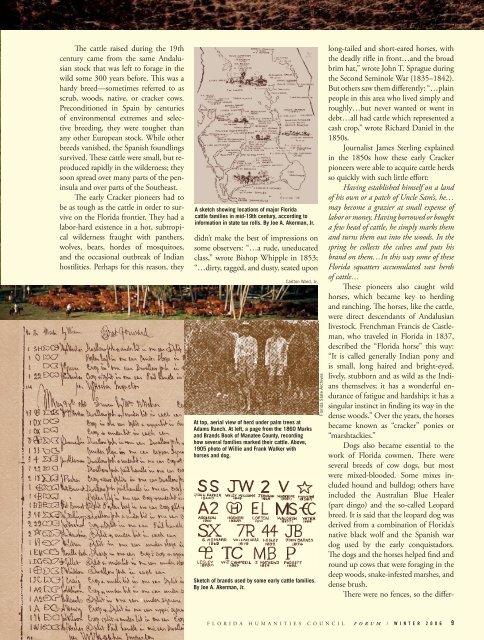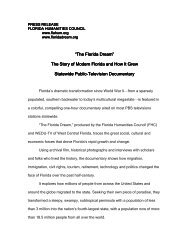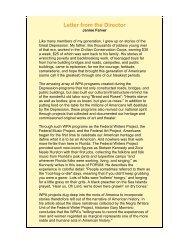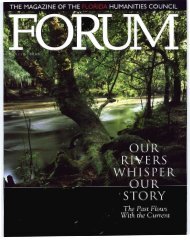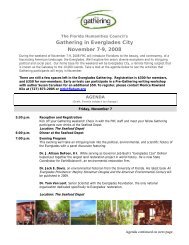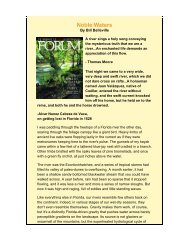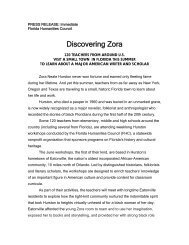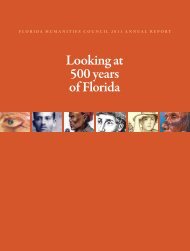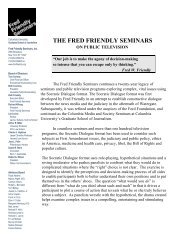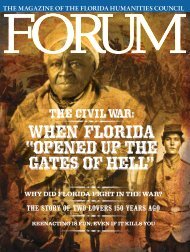THE MAGAZINE OF THE FLORIDA HUMANITIES COUNCIL
THE MAGAZINE OF THE FLORIDA HUMANITIES COUNCIL
THE MAGAZINE OF THE FLORIDA HUMANITIES COUNCIL
Create successful ePaper yourself
Turn your PDF publications into a flip-book with our unique Google optimized e-Paper software.
The cattle raised during the 19th<br />
century came from the same Andalusian<br />
stock that was left to forage in the<br />
wild some 300 years before. This was a<br />
hardy breed—sometimes referred to as<br />
scrub, woods, native, or cracker cows.<br />
Preconditioned in Spain by centuries<br />
of environmental extremes and selective<br />
breeding, they were tougher than<br />
any other European stock. While other<br />
breeds vanished, the Spanish foundlings<br />
survived. These cattle were small, but reproduced<br />
rapidly in the wilderness; they<br />
soon spread over many parts of the peninsula<br />
and over parts of the Southeast.<br />
The early Cracker pioneers had to<br />
be as tough as the cattle in order to survive<br />
on the Florida frontier. They had a<br />
labor-hard existence in a hot, subtropical<br />
wilderness fraught with panthers,<br />
wolves, bears, hordes of mosquitoes,<br />
and the occasional outbreak of Indian<br />
hostilities. Perhaps for this reason, they<br />
A sketch showing locations of major Florida<br />
cattle families in mid-19th century, according to<br />
information in state tax rolls. By Joe A. Akerman, Jr.<br />
didn’t make the best of impressions on<br />
some observers: “…a rude, uneducated<br />
class,” wrote Bishop Whipple in 1853;<br />
“…dirty, ragged, and dusty, seated upon<br />
Carlton Ward, Jr.<br />
At top, aerial view of herd under palm trees at<br />
Adams Ranch. At left, a page from the 1860 Marks<br />
and Brands Book of Manatee County, recording<br />
how several families marked their cattle. Above,<br />
1905 photo of Willie and Frank Walker with<br />
horses and dog.<br />
Sketch of brands used by some early cattle families.<br />
By Joe A. Akerman, Jr.<br />
Florida State Archives<br />
long-tailed and short-eared horses, with<br />
the deadly rifle in front…and the broad<br />
brim hat,” wrote John T. Sprague during<br />
the Second Seminole War (1835–1842).<br />
But others saw them differently: “…plain<br />
people in this area who lived simply and<br />
roughly…but never wanted or went in<br />
debt…all had cattle which represented a<br />
cash crop,” wrote Richard Daniel in the<br />
1850s.<br />
Journalist James Sterling explained<br />
in the 1850s how these early Cracker<br />
pioneers were able to acquire cattle herds<br />
so quickly with such little effort:<br />
Having established himself on a land<br />
of his own or a patch of Uncle Sam’s, he…<br />
may become a grazier at small expense of<br />
labor or money. Having borrowed or bought<br />
a few head of cattle, he simply marks them<br />
and turns them out into the woods. In the<br />
spring he collects the calves and puts his<br />
brand on them…In this way some of these<br />
Florida squatters accumulated vast herds<br />
of cattle…<br />
These pioneers also caught wild<br />
horses, which became key to herding<br />
and ranching. The horses, like the cattle,<br />
were direct descendants of Andalusian<br />
livestock. Frenchman Francis de Castleman,<br />
who traveled in Florida in 1837,<br />
described the “Florida horse” this way:<br />
“It is called generally Indian pony and<br />
is small, long haired and bright-eyed,<br />
lively, stubborn and as wild as the Indians<br />
themselves; it has a wonderful endurance<br />
of fatigue and hardship; it has a<br />
singular instinct in finding its way in the<br />
dense woods.” Over the years, the horses<br />
became known as “cracker” ponies or<br />
“marshtackies.”<br />
Dogs also became essential to the<br />
work of Florida cowmen. There were<br />
several breeds of cow dogs, but most<br />
were mixed-blooded. Some mixes included<br />
hound and bulldog; others have<br />
included the Australian Blue Healer<br />
(part dingo) and the so-called Leopard<br />
breed. It is said that the leopard dog was<br />
derived from a combination of Florida’s<br />
native black wolf and the Spanish war<br />
dog used by the early conquistadors.<br />
The dogs and the horses helped find and<br />
round up cows that were foraging in the<br />
deep woods, snake-infested marshes, and<br />
dense brush.<br />
There were no fences, so the differ-<br />
F L O R I D A H U M A N I T I E S C O U N C I L F O R U M / W I N T E R 2 0 0 6 19


